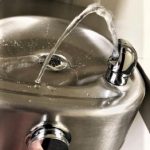Nothing is more refreshing on a hot summer day than an ice-cold glass of water! Water is an essential component to good health. In fact, it makes up 60% of your body’s weight and is involved in various metabolic processes throughout your body. Without it, you could not survive. As summer approaches, it is important to be mindful of the increasing temperatures outside since the chances for dehydration are much greater than other times of the year – especially if you are planning to spend a lot of time outdoors.
Dehydration happens when your body lacks enough water to carry out normal processes. It often occurs when you are expending more water (usually through sweat & exercise) than you are consuming, and is accelerated in warm humid climates. Dehydration is no joke, and can lead to serious medical complications such as heat stroke, heat stress, and even death. Common signs and symptoms that may indicate you are dehydrated include fatigue, headache, dry mouth, little to no urination, constipation, vomiting, muscle-weakness, dizziness, and lightheadedness. Most susceptible to heat stress and complications from dehydration include infants, older adults (65 & up), people who are overweight, and people who are excessive sweaters during physical activity. If you fall into any of those categories, try to be mindful about how much fluid you are consuming throughout the day.
How can you prevent dehydration?
While many people think they may be drinking enough, that is often not the case. Your own thirst mechanism isn’t always the best gauge to make sure you are properly hydrated. According to the National Academy of Medicine, women should consume an average of 9 ½ cups of water per day and men should be consuming 12 cups. For older adults over the age of 70, the rule of thumb is about 7 cups per day. That includes all fluids from water, coffee, and juices.
Keep in mind that needs may be different for each of us. One simple way to check your hydration status is to look at the color of your urine. If the color of your urine is a light lemonade color, you are in the clear! However, if your urine color is a dark orange, you need to start drinking some fluids to get back to a hydrated state to avoid any health complications.
Additional ways to reach your fluid intake without refilling your water bottle
Did you know water makes up the largest component of many of the foods we eat? By adding some more fruits and vegetables to your diet such as watermelon, strawberries, melons, oranges, broccoli, bell peppers, and lettuces – you are not only increasing your fluid intake but getting your necessary vitamins and minerals as well! According to the Dietary Guidelines for Americans, people should be consuming an average of 2 cups of fruits and vegetables per day.
Other factors that can influence your hydration status
Alcohol – Alcohol acts as a diuretic – meaning it turns down a hormone called antidiuretic hormone (ADH) which tells your kidneys to absorb/retain fluids. In other words, drinking a lot of alcohol will make you expel more fluids from your body. Make sure to drink extra water while enjoying alcoholic beverages to avoid becoming dehydrated.
Diet – Consuming a high-sodium diet is another cause of dehydration. Sodium is necessary in our diets, but only in very small amounts. When we consume excessive amounts of sodium, this disrupts the body’s filtration system and the kidneys begin holding onto more and more water. This leads to dehydration, bloating, edema, hypertension, and cardiovascular stress. Drinking extra water can help bring things back into balance and re-hydrate your thirsty cells!
Older Age – As we get older, thirst sensations decrease and risk for dehydration increases since older adults do not feel the need to drink as much. Additionally, many medications can influence fluid needs in the body.
Caffeine – Contrary to popular belief, caffeine does not dehydrate you. When you drink coffee, or other caffeinated beverages you are also consuming fluids. High fluid consumption leads to higher frequency of urination.
Learn to LOVE Water
Water by itself can definitely get old if it isn’t your beverage of choice. There are plenty of ways to add flavor and sweetness to your drinks without packing in tons of extra calories and sugar. Fruit infusions are a very simple way to make a boring beverage much more delicious. Try some of these delightful, thirst-quenching recipes!
Raspberry Orange Mint
- Water
- 1 cup raspberries
- 1 orange sliced up
- Mint leaves
Lemon Lime Thyme
- Water
- 1 lemon sliced
- 1 lime sliced
- 1 large sprig of fresh thyme
Blueberry Lemon Mint
- Water
- 1 cup blueberries
- 1 lemon sliced
- Nutrition and Memory - August 1, 2025
- Exercise Boosts Brain Power - July 1, 2025
- Chronic Inflammation and Dietary Habits - April 2, 2025

